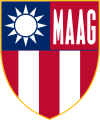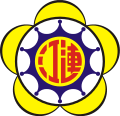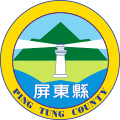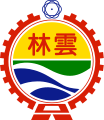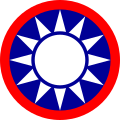Blue Sky with a White Sun
| National Emblem of the Republic of China | |
|---|---|
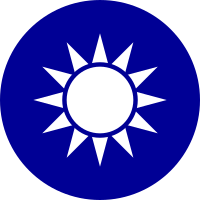 | |
| Armiger | Government of the Republic of China |
| Adopted | 17 December 1928(Nationalist government) 25 October 1945(Taiwan) |
| Relinquished | 1 October 1949(Mainland China) |
| Use | 1928–1949 (Mainland China) 1945–present (Taiwan) |
| Party Emblem of the Kuomintang | |
|---|---|
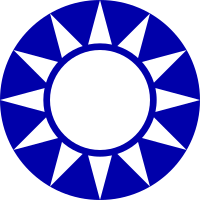 | |
| Armiger | Kuomintang |
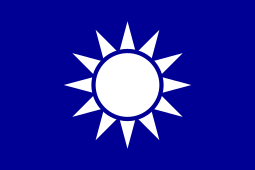 | |
| "Blue Sky with a White Sun" flag (Thanh thiên bạch nhật kỳ) | |
| Use | Kuomintang party flag and the ROC naval jack |
|---|---|
| Proportion | 2:3 |
| Adopted | 1895 |
| Design | A white sun withtwelve rayson blue background. |
| Designed by | Lu Haodong |
TheBlue Sky with a White Sun(Chinese:Thanh thiên bạch nhật;pinyin:Qīngtīan Báirì) is the national emblem of theRepublic of Chinathat covers the period of history inMainland ChinaandTaiwan.
In the "Blue Sky with a White Sun" symbol, thetwelve raysof the whiteSunrepresenting the twelvemonthsand the twelve traditionalChinese hours(Thời thần;shíchen), each of which corresponds to two modern hours and symbolizes the spirit of progress.[citation needed]
Official description
[edit]The national emblem of the Republic of China is officially described in theNational Emblem and National Flag of the Republic of China Act:[1]
The national emblem of the Republic of China is a blue sky with a white sun in the following form:
- A blue circle.
- A white sun in the middle, with 12 white rays with pointed angles.
- There is a blue ring between the white sun and the white rays with pointed angles.
The position, angle and ratio of each subparagraph of the previous article are as follows:
- The center of the blue background circle is the center of the white sun.
- The ratio of the radius of the white sun to the radius of the surrounding blue circle is 1:3.
- The length from the center of the white sun to the top of a white ray with a pointed angle is twice the length of the radius of the white sun.
- The width of the blue ring between the white sun and the 12 white rays with pointed angles is equivalent to 1/15 of the diameter of the white sun.
- The top angle of each white ray with a pointed angle is 30 degrees, with the 12 rays totaling 360 degrees.
- The upper, lower, left and right sides of the white rays with pointed angles shall be facing north, south, east and west. The rest shall be evenly spread out.
History of the Blue Sky White Sun design
[edit]| National Emblem of the Republic of China | |||||||||
|---|---|---|---|---|---|---|---|---|---|
| Traditional Chinese | Trung hoa dân quốc quốc huy | ||||||||
| Simplified Chinese | Trung hoa dân quốc quốc huy | ||||||||
| |||||||||
The "Blue Sky with a White Sun" flag was originally designed byLu Hao-tung,a martyr of theRepublican revolution.He presented his design to represent the revolutionary army at the inauguration of theSociety for Regenerating China,an anti-Qingsociety inHong Kong,on February 21, 1895.[2]
During theWuchang Uprisingin 1911 that heralded the Republic of China, the various revolutionary armies had different flags. Lu Hao-tung's "Blue Sky with a White Sun" flag was used in the southern provinces ofGuangdong,Guangxi,Yunnan,andGuizhou,while the "18-Star Flag","Five-Colored Flag",and other designs were used elsewhere.
When the government of the Republic of China was established on January 1, 1912, the "Five-Colored" flag was adopted as the national flag, but Sun Yat-sen did not consider its design appropriate, reasoning that horizontal order implied a hierarchy or class like that which existed during dynastic times. Thus, when he established a rival government inGuangzhouin 1917, he brought over the "Blue Sky with a White Sun" flag for the party and the "Blue Sky, White Sun, and a Wholly Red Earth" (Thanh thiên bạch nhật mãn địa hồng) flag, which was then the naval ensign, for the nation. This officially became thenational flagin 1928 while the "Blue Sky with a White Sun" flag was adopted as the naval jack.
The "Blue Sky, White Sun, and a Wholly Red Earth" flag has remained theflag of the Republic of Chinato this day.
National emblem and history
[edit]Beiyang period
[edit]
The national emblem of the Republic of China was derived from the Blue Sky with a White Sun flag. The emblem was designed byHe YingqinatWhampoa Military Academyin 1924 and was set as the national emblem by theLaw of national flag and national emblem of the Republic of Chinain 1928.
On the national emblem rays of sun have some distance to the edge, symbolizing the broadness of the sky, while on Kuomintang emblem the rays reach the edge, symbolizing the spirit of revolution is as powerful as the sun.
The national emblem of the Republic of China from 1913 to 1928 is calledTwelve Symbols national emblem,based on the traditional symbols on clothes of ancient Chinese emperors. It was designed byLu Xun,Qian DaosunandXu Shoushangon August 28, 1912, and was set as national emblem in February 1913. It remained as the national emblem during the Empire of China from 1915 to 1916. After theNorthern Expeditionit was replaced by the Blue Sky with a White Sun national emblem in 1928.
Nationalist period
[edit]Since 1928, under the KMT's political tutelage, the Blue Sky with a White Sun Flag shared the same prominence as the ROC flag. A common wall display consisted of the KMT flag perched on the left and the ROC flag perched on the right, each tilted at an angle with a portrait ofNational FatherSun Yat-sen displayed in the center. After the promulgation of theConstitution of the Republic of China,the party flag was removed from such a display and the national flag was moved to the center. To promote a sense of national identity, the design of the national emblem was freely available to use and was featured prominently in corporate logos, art during the era.
-
Ceiling of the sacrificial hall,Sun Yat-sen Mausoleum
-
Emblem of theCity of Canton(1926–1949)
-
Coat of arms of CardinalPaul Yü Pin,Archbishop of Nanking
Taiwanese period
[edit]Since the ROC government moved to Taiwan and especially in the years since the end ofmartial lawthe KMT flag has lost some of its prominence. However, it is still frequently seen on KMT party buildings, in political rallies and other meetings of KMT and thepan-blue coalition.
The flag and the symbol made news during theROC legislative elections of 2004,when President Chen Shui-bian suggested that the Kuomintang's flag and party emblem violated the ROC's National Emblem Law for being too similar to the national emblem of the Republic of China. Chen stated that the law forbids the ROC's emblem and flag from being used by non-governmental organizations and warned that the KMT would have three months to change its flag and emblem if his Democratic Progressive Party won a majority of seats in the legislature. The KMT responded by asking the government to change the national emblem, saying the KMT emblem existed first. However, thepan-green coalitionfailed to win a majority, and Chen took no action for the remainder of his presidency.
On 29 January 2021, the Legislative Yuan passed a resolution proposed by theNew Power Partyon 29 January instructing the Ministry of the Interior (MOI) to look into ways of addressing the issue of the similarity between the national emblem, in use since 1928 for all of China, and the KMT party flag.[7]The MOI responded that through their analysis of the current situation, the change "should not be taken lightly," though suggesting that symbols of political parties could be changed.[8]
-
The KMT (sides) and ROC (center) flags displayed at a party building inKaohsiung.
-
TheTaiwan Railway Administrationalso used KMT emblem as their logo from 1945 to 1950.
Use in other countries
[edit]The design of "Blue Sky with a White Sun" was used in the unit insignia or coats of arms of some units of theUnited States Armythat fought inWorld War II.The most famous unit wasMerrill's Marauders(officially named the "5307th Composite Unit (Provisional)" ), which has the "Blue Sky with a White Sun" as part of its badge. The usage by US troops was a result of cooperation between US andChinese Expeditionary Forcein theChina Burma India Theater.Postwar US military units stationed inTaiwan,including theUnited States Taiwan Defense Command(USTDC) and theMilitary Assistance Advisory Group(MAAG), also used the design in their badges.
Up to now, the "Blue Sky with a White Sun" can still be seen in the emblem of theUS Army75th Ranger Regiment.
-
China Burma India Theater
-
Merrill's Marauders
-
75th Ranger Regiment
-
Military Assistance Advisory Groupin Taiwan
-
Flag of the People's action Party of Vietnam
Other emblems
[edit]Historical Taiwanese emblems
[edit]Taiwan's earliest emblems were used during the European periods.
In 1895, Taiwan was annexed byJapan.[9]The emblem was worn as an official clothing of the Governor's Office in Taiwan which featured a Daijishō with a Sycamore leaf and chrysanthemum branch in a brown circle.[10]
After theend of Japanese period,Taiwan wastransferredto theRepublic of Chinawhich adopted the Blue Sky with a White Sun emblem. This symbol remains in use to this day in Taiwan and by the Kuomintang.
Chinese Taipei
[edit]After thePeople's Republic of China became an IOC member,the ROC began to use the nameChinese Taipeifor its competitions. The crest of the Chinese Taipei Olympic Committee includes symbols of the Olympic Committee and the Chinese Taipei team. At the periphery is a stylizedplum blossomthat symbolizes theNational Flower of the Republic of China.The center of the emblem contains theOlympic ringsand the Blue Sky with a White Sun (the proportion of the blue field is between that of theNational Emblem of the Republic of Chinaand the Party Emblem of theKuomintang).[11]The Olympic flag of Chinese Taipei depicts the emblem on a white field.
Subdivisions
[edit]Provinces (streamlined)
[edit]Counties
[edit]-
Hsinchu County(2016-2019)
-
Hualien County(before 2010)
Gallery
[edit]-
Spanish Formosa(1624–1642)
-
Dutch Formosa(1624–1668)
-
Emblem on the flag ofKingdom of Tungning(1661–1683)
-
Seal ofTaiwan under Qing rule(1683–1895)
-
Republic of Formosa(1895)
-
Emblem used duringJapanese rule(1895–1945)
-
Standard of thePresident of the Republic of China(1928–present, revised in 1988)
-
Emblem of the Republic of China (1928–present) and Roundel of theRepublic of China Air Force(1991–present)
-
Roundel of theRepublic of China Air Force(1928–1991)
-
Roundel of theRepublic of China Air Force(1928–1991), light version
-
Roundel of theRepublic of China Air Force(1991–present), light version
-
Emblem of theNational Reorganized Government of the Republic of China(1940–1945)
-
Emblem ofChinese Taipei(1981–present)
-
Emblem of the Republic of China with encircling text as depicted onTaiwan passports(2021–present)
See also
[edit]- History of the Republic of China
- Politics of the Republic of China
- Chinese Taipei
- Flag of the Republic of China
- Proposed flags of Taiwan
References
[edit]Citations
[edit]- ^National Emblem and National Flag of the Republic of China Act, English
- ^"National flag".english.president.gov.tw.Retrieved2020-11-17.
- ^Flight International.April 28, 1938. p.416Archived2014-10-06 at theWayback Machine(Archive). "EURASIA AVIATION CORP., 97, Jinkee Road, Shanghai."
- ^"Eurasia Aviation Corporation - A German-Chinese Airline in China and its Airmail 1931-1943 by Peter Moeller and Larry D. Sall, paperback in color, 2007, 153 pages, great book on the history of this airline, includes a listing of First Flight covers and catalog valuesArchived2014-10-06 at theWayback Machine."China Stamp Society. Retrieved on October 4, 2014.
- ^Ballantine, Collin and Pamela Tang. "Chinese airlines: airline colours of China."Airlife,1995. p.6."Chinese Ministry of Communications which declared Eurasia to be a Chinese State-owned airline. The airline then fell into more trouble as a direct result of the continuing Japanese occupation. The fleet of airliners was based in Hong Kong[...]"
- ^Ballantine, Collin and Pamela Tang. "Chinese airlines: airline colours of China."Airlife,1995. p.5."The outcome of this venture was Eurasia Airlines, operating six- seater Junkers W33 airliners across Asia into China."
- ^"Taiwan weighing necessity of changing national emblem".Taiwan News.30 March 2021.
- ^Wu, Su-wei (10 April 2021)."Report suggests changing KMT emblem".Taipei Times.
- ^"アルテモンド đậu tri thức / ななこ chức".www.artemondo.co.jp.
- ^"Thủy chính tứ thập chu niên ký niệm đài loan bác lãm hội tả chân thiếp - quốc lập quốc hội đồ thư quán デジタルコレクション".dl.ndl.go.jp.
- ^"Mê để yết khai: Nguyên lai trung hoa áo hội nhất trực dụng đảng huy xuất tái".20 September 2016.Archivedfrom the original on 2016-12-20.Retrieved2016-12-18.
Sources
[edit]- Hong, Caroline (2004-11-23)."Debate heats up over claims to the sun".Taipei Times.p. 3.
External links
[edit]- Kuomintang– official website
- sac.gov.tw: Bổn kỳ chuyên đề: Áo hội mô thức(in Chinese)




![Roundel of Eurasia Aviation Corporation, a defunct Chinese airline headquartered in Shanghai. [3][4][5] [6]](https://upload.wikimedia.org/wikipedia/commons/thumb/7/76/Roundel_of_the_Republic_of_China_%281930%E2%80%931943%29_%E2%80%93_Eurasia_Aviation_Corporation.svg/120px-Roundel_of_the_Republic_of_China_%281930%E2%80%931943%29_%E2%80%93_Eurasia_Aviation_Corporation.svg.png)





